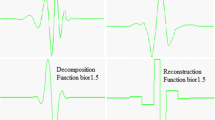Abstract
Signal compression is gaining importance in biomedical engineering due to the potential applications in telemedicine. In this work, we propose a novel scheme of signal compression based on signal-dependent wavelets. To adapt the mother wavelet to the signal for the purpose of compression, it is necessary to define (1) a family of wavelets that depend on a set of parameters and (2) a quality criterion for wavelet selection (i.e., wavelet parameter optimization). We propose the use of an unconstrained parameterization of the wavelet for wavelet optimization. A natural performance criterion for compression is the minimization of the signal distortion rate given the desired compression rate. For coding the wavelet coefficients, we adopted the embedded zerotree wavelet coding algorithm, although any coding scheme may be used with the proposed wavelet optimization. As a representative example of application, the coding/encoding scheme was applied to surface electromyographic signals recorded from ten subjects. The distortion rate strongly depended on the mother wavelet (for example, for 50% compression rate, optimal wavelet, mean±SD, 5.46±1.01%; worst wavelet 12.76±2.73%). Thus, optimization significantly improved performance with respect to previous approaches based on classic wavelets. The algorithm can be applied to any signal type since the optimal wavelet is selected on a signal-by-signal basis. Examples of application to ECG and EEG signals are also reported.






Similar content being viewed by others
References
Burrus CS, Gopinath RA, Guo H (1997) Introduction to wavelets and wavelet transforms. Prentice-Hall, Englewood Cliffs, pp 53–66
Clarke LP, Qian W, Kallergi M, Venugopal P, Clark RA (1998) Hybrid wavelet transform for image enhancement for computer-assisted diagnosis and telemedicine applications. In: Akay M (ed) Time frequency and wavelets in biomedical signal processing. IEEE, Piscataway
Istepanian RSH, Petrosian AA (2000) Optimal zonal wavelet-based ECG data compression for a mobile telecardiology system. IEEE Trans Inf Technol Biomed 4:200–211
Jalaleddine SMS, Hutchens CG, Strattan RD, Coberly WA (1990) ECG data compression techniques: a unified approach. IEEE Trans Biomed Eng 37:329–343
Jensen A, La Cour-Harbo A (2001) Ripples in mathematics. Springer, Berlin Heidelberg New York, ISBN: 3-540-41662-5
Lawton W (1990) Tight frames of compactly supported affine wavelets. J Math Phys 31:1898–1901
Lawton W (1991) Necessary and sufficient conditions for constructing orthonormal wavelet base. J Math Phys 32:1440–1443
Madeleine P, Farina D, Merletti R, Arendt-Nielsen L (2002) Upper trapezius muscle mechanomyographic and electromyographic activity in humans during low force fatiguing and non-fatiguing contractions. Eur J Appl Physiol 87:327–336
Maitrot A, Lucas MF, Doncarli C, Farina D (2005) Signal-dependent wavelets for electromyogram classification. Med Biol Eng Comput 43(4):487–492
Mallat S (1989) A theory for multiresolution signal decomposition: the wavelet representation. IEEE Trans Pattern Anal 11:674–693
Mallat S (1999) A wavelet tour of signal processing. Academic Press, New York
Norris JA, Englehart KB, Lovely DF (2003) Myoelectric signal compression using zero-trees of wavelet coefficients. Med Eng Phys 25:739–746
Proakis J (2001) Digital communications. McGraw-Hill, New York
Rajoub BA (2002) An efficient coding algorithm for the compression of ECG signals using the wavelet transform. IEEE Trans Biomed Eng 49:355–362
Selesnick IW (1997) Maple and the parameterization of orthogonal wavelet bases. Available online: http://www.taco.poly.edu/selesi/theta2h/
Shapiro JM (1993) Embedded image coding using zerotrees of wavelet coefficients. IEEE Trans Signal Proc 41:3445–3462
Vaidyanathan PP (1996) Multirate systems and filter banks. Wellesley–Cambridge Press, London
Wellig P, Cheng Z, Semling M, Moschytz GS (1998) Electromyogram data compression using single-tree and modified zero-tree wavelet encoding. In: Proceedings of IEEE–EMBS, pp 1303–1306
Yloestalo J (1999) Data compression methods for EEG. Technol Health Care 7:285–300
Acknowledgements
The authors are grateful to Pascal Madeleine for providing the experimental signals used for testing the compression algorithm. The study was partly supported by the project “Cybernetic Manufacturing Systems” (CyberManS), financed by the European Community.
Author information
Authors and Affiliations
Corresponding author
Rights and permissions
About this article
Cite this article
Nielsen, M., Kamavuako, E.N., Andersen, M.M. et al. Optimal wavelets for biomedical signal compression. Med Bio Eng Comput 44, 561–568 (2006). https://doi.org/10.1007/s11517-006-0062-0
Received:
Accepted:
Published:
Issue Date:
DOI: https://doi.org/10.1007/s11517-006-0062-0




